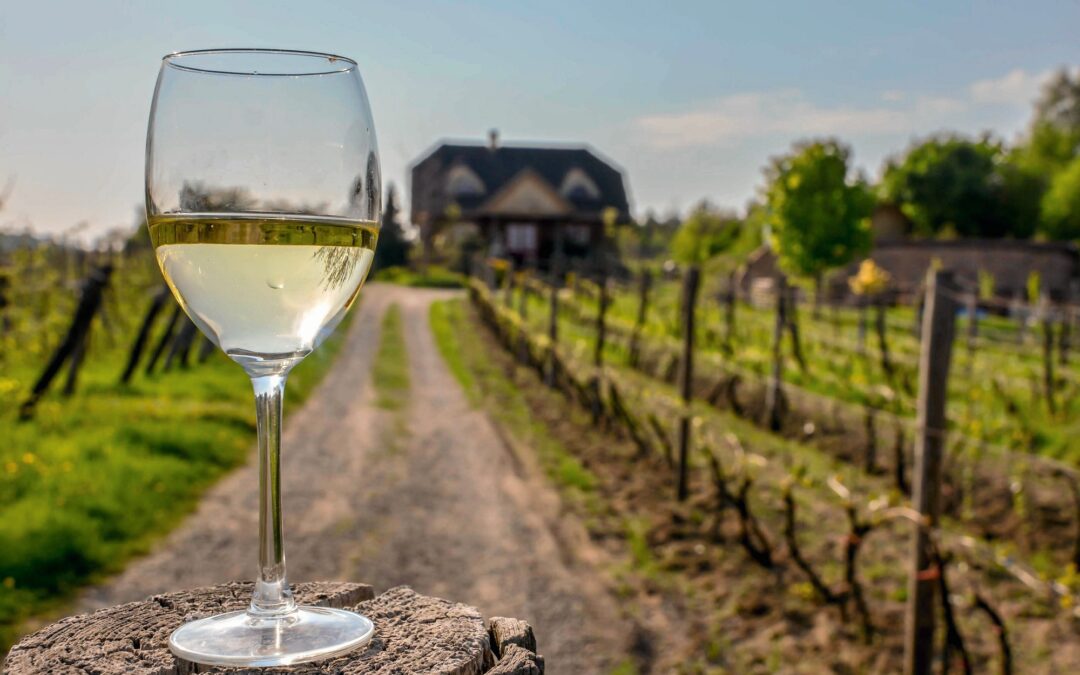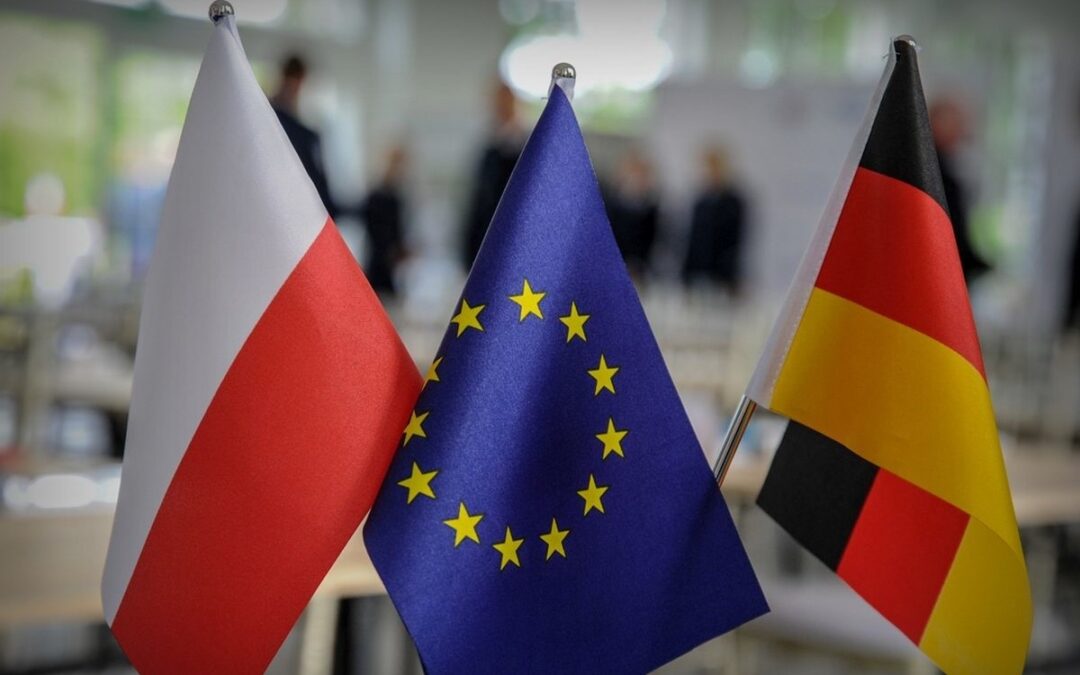By Inka Wrońska (tekst dostępny również w wersji polskiej)
Vineyards were once widespread in Poland, but disappeared amid a cooling climate, the upheaval of wars and occupation, and then decades of communist rule. Now a new generation of winemakers is reviving the industry, and global warming could boost it further.
“Thirty years ago, our country, a barefoot sprinter, shot out of the blocks, not knowing where to run, what the distance was and behind which bend it would see its rivals’ backs,” wrote Marek Kondrat, a well-known Polish actor and wine importer, describing the beginnings of Polish winemaking in the introduction to this year’s edition of the guidebook Polskie Wina (Polish Wines). “Young Polish vineyards are like a promising child,” he added.
Modern Polish winemaking is still in its infancy. Only in June 2009 did the first official and legal Polish wine go on sale – a Feniks 2008 from Jaworek vineyard. In the 2009/10 season, 21 vineyards declared their intent to put wines on the market; the figure now is 380.
Registered vineyards in Poland occupy 630 hectares (1,557 acres), while unregistered ones might account for the same area again. This figure is tiny in comparison to the several dozen thousand French, Spanish and Italian vineyards – but Polish wine is increasing in popularity.
A good vintage
Winemaking in the Polish lands began to develop in the 12th century, at the time of the so-called Medieval Climate Optimum (English vineyards also fared well at the time). This is indicated by the names of places founded at the time, such as Winne Góry, Winiary, and Winogrady.
Wine production was initially the preserve of Cistercian and Benedictine monks, but they were soon joined by burghers from Kraków, Przemyśl, Zielona Góra, Sandomierz and Krosno. If not for the marked cooling of the climate in the 17th century (the so-called Little Ice Age), with temperatures falling by at least one degree Celsius, today Poland might well have viticultural traditions to rival France.
Really taken with the hard work and imagination of @kbarczentewicz, a young Polish winemaker who started his 12ha limestone plots in 2017 and has already won acclaim for his first ever red #wine from last year’s harvest pic.twitter.com/dRsomZXfEX
— Maria Wilczek (@mariawilczek) August 22, 2021
The problem with the cold was exacerbated from time to time by events not conducive to winemaking: first devastating wars, then grape phylloxera (an insect pest). Finally, after the Second World War, came communism, when there was scant interest in taking care of the vineyards in lands inherited after the war from Germany – the last of which closed down in 1974. Wine in Poland thereby died a natural death.
Although the vineyards were no more, the country still had its “wine”. This was made at home from strawberries or currants, while shops stocked cheap sulphurised apple wines. In the 1980s and ‘90s or a little earlier, foreign wines appeared, represented by the Bulgarian Sophia Melnik and the Hungarian Egri Bikavér. Yet these too were not the best quality, to put it mildly.
New beginnings
Around the same time, Polish winemaking began to stir. Among the pioneers of its resurrection was Roman Myśliwiec, who in 1982 founded the Golesz vineyard in the Podkarpacie province (and then a nursery of strains that are happy in our climate). Today, his vineyard is run by his son Bartłomiej, and the ice wine Polaris being grown there is especially notable.
Golesz was the first vineyard in Poland, but others soon followed – not only in Podkarpackie. In the 19th century, there were more than 2,200 vineyards in the Zielona Góra area in western Poland alone, and prospective Polish winemakers in the region soon returned to these traditions.
The Kinga vineyard opened as early as 1985, followed a decade later by Stara Winna Góra. More ensued in the early 21st century: Mierzęcin Palace and Miłosz vineyard in 2004, Equus in 2006, and Gostchorze in 2009.
Neighbouring Lower Silesia’s viticulture also developed: 2001 saw the beginning of the Jaworek vineyards, Jakubów opened in 2002, Katarzyna in 2003, and Wzgórza Trzebnickie in 2008. The Płochocki vineyard in the Świętokrzyskie Province, founded in 2002, is another of Poland’s oldest producers.
Our recital is also a promotion of the region. After a recital in the beautiful Palace of the National Museum, we will taste wine from the region Swietokrzyskie. We are proud – the best vineyards will show us their collections: Vineyard Plochockich, Nobilis, Kedrow, Na Rozdrozu https://t.co/gJ97NPIClR pic.twitter.com/2Nlb65BxO4
— Mariusz Jablonski (@Mariusz_1976MJ) October 7, 2019
When it became legal to sell homegrown wine in 2009, owning a vineyard stopped being just an eccentric hobby for a select few. This could be why so many new ones have opened. For instance, there is the Turnau vineyard in Western Pomerania since 2011, Wieliczka in Małopolska since 2013, and Skarpa Dobrska in Lubelskie since 2014.
Poland’s wine map is slowly filling up, and while Lower Silesia, Lubuskie, Małopolska, Podkarpackie and Świętokrzyskie are still the main centres of production, there are also good vineyards elsewhere, such as in Warmia and Masuria and the Łódź area. It might be hard to believe, but wine production is today one of the most dynamic sectors of the Polish economy.
W Polsce nastał czas na wino. Dynamicznie przybywa upraw winogron i producentów tego trunku. https://t.co/U05Kig7ctf pic.twitter.com/Ng5wIBPiql
— Gazeta Wyborcza.pl (@gazeta_wyborcza) June 18, 2016
Trial and error
In 2011, when Poland was president of the European Council, the country’s wine made its debut at official events. The exception was the Eastern Partnership Summit, when Radosław Sikorski, the then foreign affairs minister, decided that Hungarian wines would be a safer choice.
And ordinary punters are no doubt thinking along the same lines when they continue to prefer tried-and-tested Chianti or Bordeaux in restaurants, not trusting Polish Regent. Agnieszka Kręglicka, a co-owner of several food spots in Warsaw, admits that especially early on there were many unsuccessful and even poor Polish wines.
“But of course, we don’t have winemaking traditions in our country,” she explains. “The Italians and French made their errors over centuries and had time to fix them. We have to make do with half a generation.”
Robert Trzópek, head chef at the Bez Gwiazdek restaurant (an excellent neo-bistro with modern Polish cuisine), told me a few years ago that “Our vineyards are small, the vintages vary, and the wines are simply too expensive.”
Now, however, we can find three interesting Polish vineyards on his menu, none of them particularly large: Król (Świętokrzyskie Province, 6 hectares), Ingrid (Lubuskie, 2.5 hectares), and Zamojska from Roztocze in eastern Poland (just 1 hectare).
Aleksander Baron, head chef at the fashionable Baron the Family restaurant in Warsaw, has been backing domestic wines from the outset. When he opened the venue in 2020, it had only Polish wines on the menu. Today, there are a few foreign ones too, but Polish vineyards, including Moderna, Płochocki, Gostchorze, Saganum and Rymanów, make up the majority.
Who are Poland’s winemakers?
“The vast majority are absolute enthusiasts,” writes wine journalist Maciej Nowicki in Polish Wines.
Polish winemakers, he says, can be divided into two groups. The first are smaller ventures (usually vineyards of 1-2 hectares), which, “bit by bit”, open a series of investments – a professional winery, a tasting room, a vinitourism section.
The second, growing group, meanwhile, includes businesses that make a splash from the outset. “The areas of these vineyards are noticeably larger (from 7-8 or even more than a dozen hectares planted immediately), with market premiums accompanied by a winery and vinitourism building, sometimes adapted from a historical palace or manor, Nowicki writes.
“In most cases, in both groups it is the owner himself who produces the wine, often supported by the whole family, although at times an external oenologist is employed,” says Nowicki.
He adds that vinification methods are also changing. Wines aged in steel barrels were initially dominant. This was partly for prosaic reasons: winemakers could not always afford oak barrels.
It turned out, however, that longer oak ageing suited the red varieties that are most popular among makers and consumers in Poland: Regent, Rondo, Pinot Noir and Cabernet Cortis. For the time being, oak-aged white wines are much rarer.
“But this will no doubt change as more grapevines that suit it are planted,” writes Nowicki. “Even now one can find Rieslings and Chardonnays created in this way.”
Some Polish winemakers are favouring other methods. A few (e.g. De Sas and Płochocki vineyard) use kvevri, Georgian earthenware vessels, in which the wine is fermented on grape skins. Kamil Barczentewicz’s vineyard, meanwhile, has tried using concrete “eggs” to ferment and age Pinot blanc and Chardonnay.
What is wine made from in Poland?
Just ten years ago, we would have said mainly from hybrids, meaning blends well adapted to our climate. Popular ones are both white – Bianca, Hibernal, Seyval Blanc and Sibera – and red – Léon Millot, Maréchal Foch, Regent and Rondo.
So-called PIWI wines – promising fungus-resistant new-generation hybrids – are also at home in Polish vineyards. These include Solaris, Souvignier Gris and Muscaris (white) as well as Cabernet Cortis, Cabernet Jura and Cabernet Dorsa (red).
Today, many winemakers in Poland are taking a punt on Vitis vinifera, the common grapevine. Such varieties as Riesling, Chardonnay, Gewürztraminer and Grüner Veltliner, and Pinot Noir, Zweigelt, and even Cabernet Sauvignon and Merlot, are increasingly thriving.
A warming in the climate has meant that these noble varieties are doing especially well in Lower Silesia, Lubuskie, the Vistula River Gorge of Małopolska and Western Pomerania. Winemakers’ growing interest has also been a factor.
“At the beginning of the contemporary history of Polish winegrowing, most makers were self-taught, getting their knowledge from books or the internet and producing wine by trial and error,” writes Maciej Nowicki. Today, many of them have courses and training to their name, both in Poland – offered by the Podkarpackie Wine Academy, for example – and abroad.
In keeping with global trends, Polish winemaking is also making bold moves towards sparkling wines (both produced using the traditional method and pét-nats made with an ancient method without secondary fermentation).
There are also orange wines, meaning those made from white varieties macerated on grape peels. These are popular in restaurants, as they accentuate the oiliness of food and the so-called “brothy” taste, and also go well with pickles. Finally, production of rosés is also increasing.
Where can you try Polish wine?
Visiting Poland with a glass in hand is increasingly easy. The best place to do so is at a vineyard. More are springing up all the time, many with agrotourism opportunities attached. A good vinitourism guide can be invaluable – you can’t go wrong with Polish Wines, published in 2021 by Ferment magazine and the website Winicjatywa.pl.
A broader overview of what Polish winemaking has to offer is provided by various industry events. The most popular in Poland include the Wine Festival in Janowiec, the Festival of Polish Wines at SPOT. in Poznań, International Days of Wine in Jasło, the Zielona Góra Wine Fest and the Young Wine Festival in Sandomierz.
Most Polish restaurants worth their salt now have Polish labels on the wine menu. An improving selection is also offered by specialist shops, wine bars, supermarkets, and even discount chains, such as Lidl (including wine from the Lipka Wielka vineyard in Wielkopolska) and Biedronka (the odNowa brand from the Dwórzno vineyard).
Polish Wines’ recommendations of the “most exciting” vineyards and wines of the season
Dolnośląskie
- Jakubów vineyard (Yacobus Copernico 2019)
- Wzgórze Trzebnickie vineyards (Pinot Gris 2019 and Pinot Noir Barrique 2017 i 2018)
Lubelskie
- Dom Bliskowice vineyard (J’Ultra 2018, Pinot Noir 2017)
- Dwór Sanna vineyard (Johanniter Pét-Nat 2018)
- Skarpa Dobrska vineyard
Lubuskie
- Mierzęcin Palace Wellness & Wine Resort
- Stara Winna Góra vineyard
- Equus vineyard (Kadryl 2019, Young Karmazin 2020)
- Gostchorze vineyard (Brut Riesling Blanc de Blancs 2018)
- Miłosz vineyard (Pandemic Orange 2019)
Małopolskie
- Wieliczka vineyard
Podkarpackie
- Półtorak vineyards (Palava 2019)
Świętokrzyskie
- Płochocki vineyard (Pinot noir 2018)
Zachodniopomorskie
- Turnau vineyard (Riesling 2018)
- Kojder vineyard (Souvignier gris 2019)
Translated by Ben Koschalka. Main image credit: Władysław Czulak / Agencja Gazeta





















